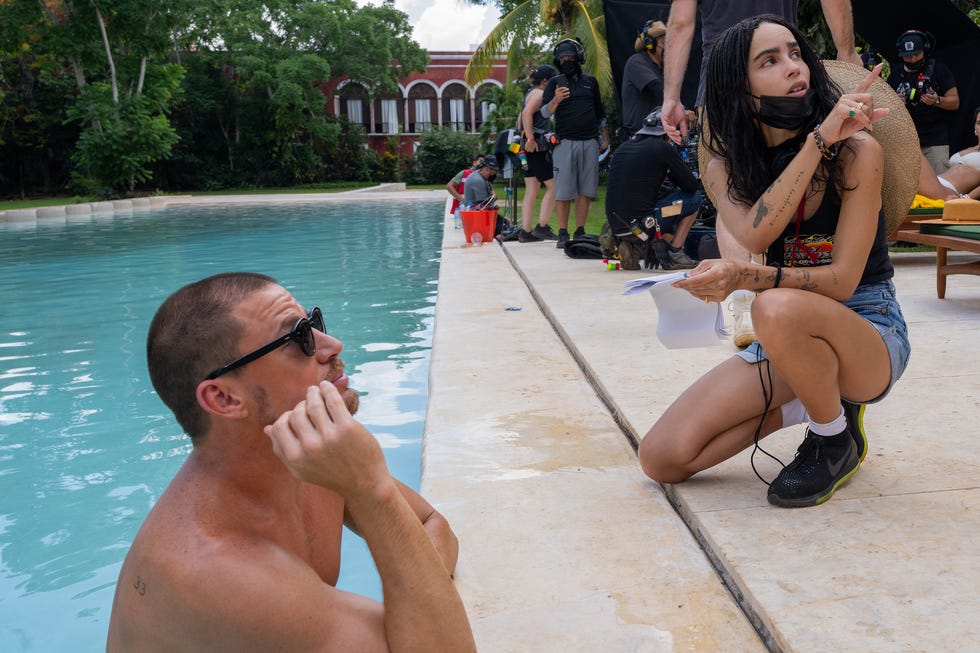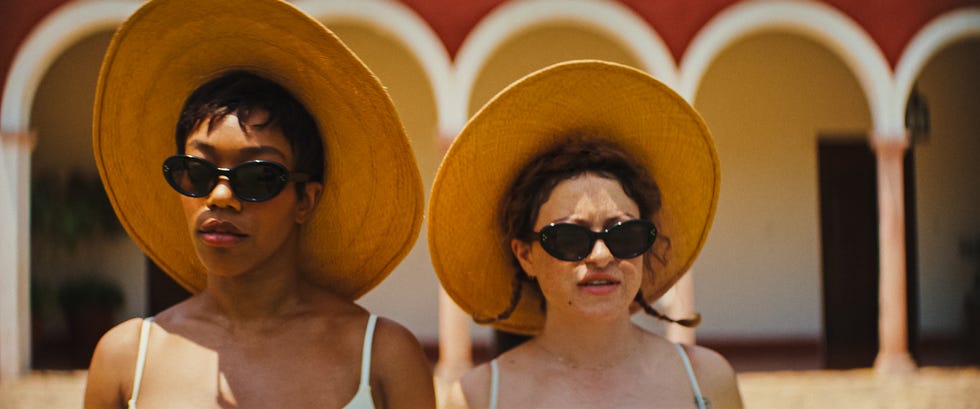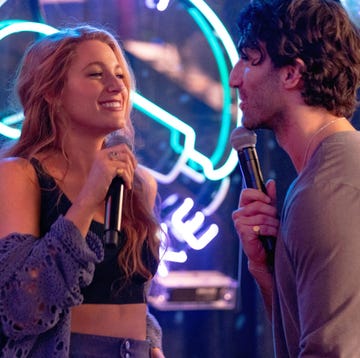Warning: Slight spoilers ahead.
A slow-burn psychosexual thriller set in Mexico’s tropical Yucatán? Color us interested. Zoë Kravitz’s directorial debut, Blink Twice, just arrived in theaters and from what we’ve seen, it’s a doozy in the best possible way. The story follows Naomi Ackie as Frida, a waitress who gets entangled with billionaire tech mogul Slater King (played by Kravitz’s beau, Channing Tatum) and travels with him to his private island for an over-the-top party. Things start to get freaky when her friend Jess (Alia Shawkat) goes missing. Part Get Out, part The White Lotus, Blink Twice is by turns suspenseful, thrilling, emotional—and deeply stylish. But not in the ways you might think.
“It’s funny. When thinking about this film, I realize there’s not that many costumes to discuss,” says Costume Designer Kiersten Hargroder, who worked alongside fellow designer Colleen Atwood on the film. The movie’s plot unravels like invisible ink under a flame, and every costume in which we see the cast of women serves a particular purpose. Specifically, a white bathing suit and a white dress both—no spoilers here—serve very particular purposes. And in a design scheme where each look requires surgical levels of precision, every detail counts.
“Because of that, each piece was looked at in a lot more depth than some other projects where you have quite a volume of costumes,” Hargroder says. “These small details of which fabrics we were using and exactly which color of white we used, we became very OCD about them, because we had only a couple of things to think about.”
Here, we caught up with Hargroder to learn more about her work on Blink Twice, about what it was like to work with Kravtiz as a director, and the unique challenges posed by filming in paradise.
First of all, we need to discuss working with Zoë Kravitz as director. The world obviously knows her as an actor, and as a person with a deep sense of personal style—but what is she like as a director?
She absolutely has a sense of style, and it comes across when she’s directing. She has opinions and feelings about how things should look, but she’s also such a hard worker. She has an intensity which is so good—you need that in a director. She is so focused on how to get things done. And being a writer, too, lends a level of being able to be creative as a director, because she’s able to understand the point of the script, if that makes sense.
Specifically with the film’s costuming—was she very collaborative with the clothes?
She gave us some inspiration, and her images were kind of all over the place in a good way. There were references from the ’50s, ’60s, ’70s, ’80s, and ’90s, and there was this through line of an aspirational vibe. From her references, we honed it in and figured out what was doable. Zoë was very collaborative and had a lot of feelings about what the film should be. It was all about timelessness and not being too trendy. There’s not a ton of clothing in the film, so we needed to be very specific about the items we used, so that could translate to that feeling Zoë wanted.
So every piece mattered. What’s an example of that?
I think you look at the two-piece or one-piece swimsuits that the women wear. There’s something really simple about the design, and obviously, the palette is simplistic. There’s not a lot of adornment or pattern used. It’s minimalistic in that way, but even the shape of the swimsuit bottoms and tops is really timeless. We wanted the story, the character, and the moment to come through. The hats that the women wear in the film—there’s something timeless about the shape. It’s almost hard to pinpoint where that inspiration comes from.
You’ve mentioned trying to achieve a certain timelessness. Did you do that through building your own costumes, through working with brands, through sourcing vintage, or all of the above?
We definitely looked at some vintage inspiration, but because of the multiples we needed and all of the blood work [special effects], at least 50 percent or more was manufactured for the film. And beyond that, there is a wide range of pieces we sourced from brands. Geena Davis wears some Zara pieces—with so much blood work, and being in and out of the pool, and people sweating in this weather, we needed a lot of multiples to keep the clothes looking fresh. Most of the shirts Channing wears were manufactured at a bespoke tailor shop in Los Angeles called Anto, and he wears two pairs of white pants in the film—one from the Row and one from Armani. Obviously, Zoë is a big fan of the Row, so we couldn’t leave them out. And at the gala scene, Frida at the end is wearing Saint Laurent, but in the beginning she’s wearing a cheaper dress we found at Bloomingdale’s, so you see the arc of her character change through the film.
In many films, costumes are used as a way to showcase or embody character development. But that doesn’t seem to be the case here as much.
I think this is a challenging question, because the women are dressed all the same when they’re on the island, so there isn’t a lot of room for character development in that sense. And obviously that’s by design—it’s about how these men underestimate the women and objectify them by making them all the same. The arcs are more portrayed through the acting.
Was shooting on Mexico’s Yucatán Peninsula a challenge? I imagine there are fewer resources than if you shot in a place like Los Angeles or Vancouver or New York.
That’s an understatement. It was very challenging for many reasons. The dress that all the women wear on the island—because of the shooting and blood work and stunt doubles, we had to manufacture something like 70 of those dresses. Just getting silk fabric to Mexico is an issue, so we had to import all of that, and then find people to manufacture all of it. We were also an hour outside of this urban area, and then there was the weather to contend with. It was the most challenging film I’ve ever been a part of.
So how did you pull it off?
Zoë was very supportive and make sure we had what we needed to facilitate this crazy schedule.
Aside from commissioning all those dresses, what made shooting difficult?
We didn’t have access to laundry and everything was white, so we were actually hand-washing everything every night or day on the offside of the schedule. And everything was white, which is working against you when there’s blood and makeup and sweat!
I’ve heard that white is pretty tricky to film.
Color is something you analyze frequently, and white is something that, for a lot of costume designers, we have a deep relationship with! It was a discussion with the cinematographer and Zoë about the blood work, about what works best on the silk, about how those fabrics function and the style of the fabric. Normally, you use a deepened shade of white, so that it’s more flattering to the skin tone of your actors. Normally, we wouldn’t use optic white on camera, because it’s so jarring and contrasting and doesn’t necessarily photograph well—but because we were shooting dresses mainly at night, it allowed us some more room to think about what the color should be.
Are there any small details that you’re especially proud of in the costumes, that might not be apparently visible to the audience at first glimpse?
Getting the dresses right was tricky, because they needed to serve all these purposes. These needed to flow and look aspirational and pretty and feminine—but they were also a form of torture. The dress bow in the back has these long, flowing pieces of fabric that are also used to tie up the women. It’s not overtly obvious when you’re watching that the dress is a form of torture, but still looks like a pretty dress.
Was there anything your actors tried to steal from set?
I think there was a pair of Oliver Peoples sunglasses we used on Channing that he liked, and that Zoë liked the shape of on him. Otherwise, not really. But the women hated the dresses so much that when we wrapped production they burned one of them in Mexico. Maybe I shouldn’t have said that! But they definitely didn’t want to steal those dresses, because they were used in these highly emotionally charged scenes, they were difficult to produce and became the bane of our existence, and because of what they represented in the film.
It’s so interesting that costumes can mean one thing onscreen to the audience, and can mean something totally different to the actors on set.
Almost always. Maybe not always, but it’s wild. There’s a lot more feeling and stories to a lot of costumes, for sure.
This interview has been edited and condensed for clarity.
Todd Plummer is a Boston-based writer who covers style, entertainment, and travel. He is a graduate of McGill University and Saint John’s University School of Law.
















